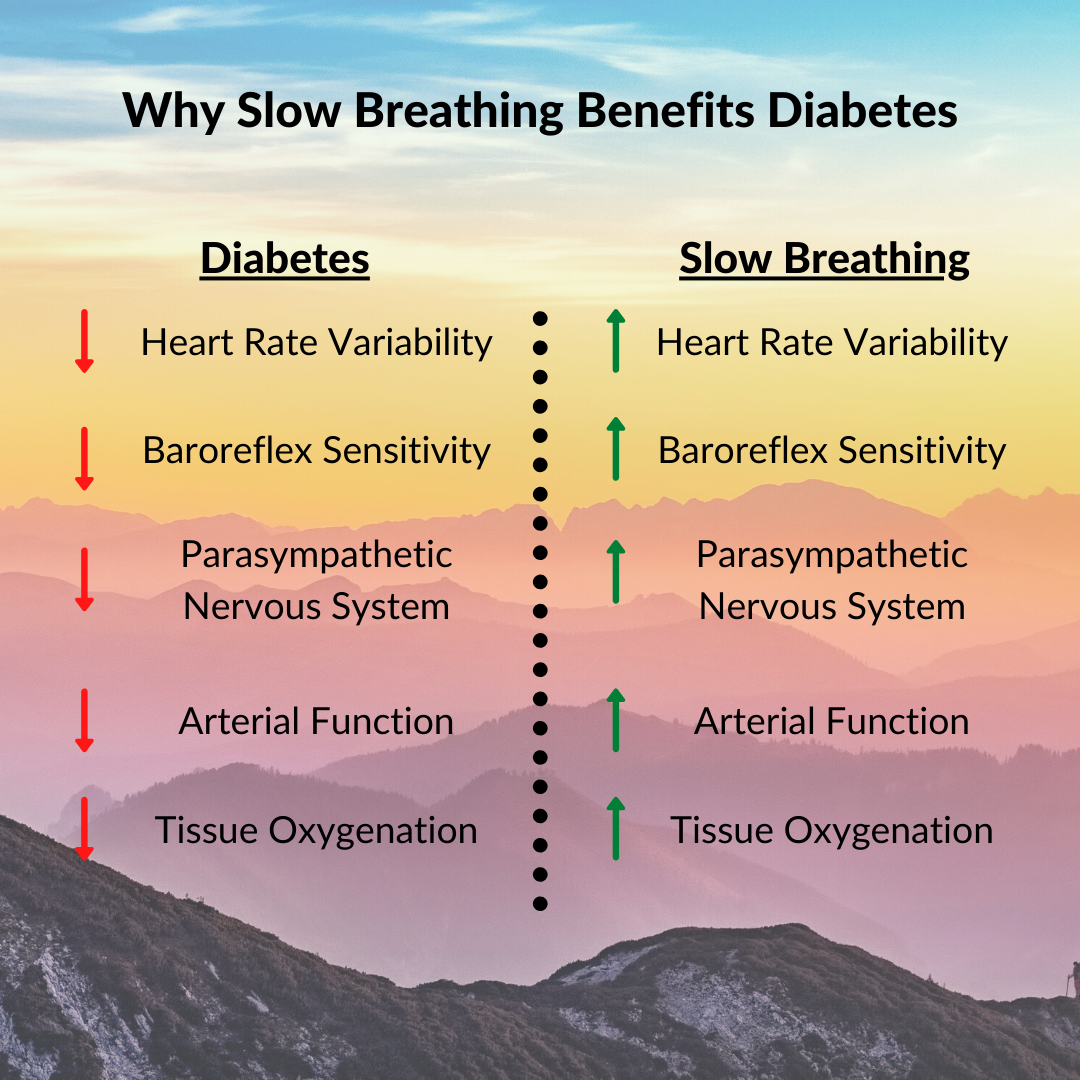Principle 2: Breathe Slowly
“Slow Breathing Could Be A Simple Beneficial Intervention in Diabetes” -Nature
The Benefits of Slow Breathing
Slow breathing is the quickest way to “flip the switch” and restore balance to your cardiovascular, autonomic, and respiratory systems. Slow breathing also helps with stress, anxiety, and panic attacks. All of these changes have profound benefits for diabetes.
Slow Breathing and Cardio-Autonomic Balance
Heart Rate Variability
One way that slow breathing improves cardio-autonomic balance is by increasing heart rate variability (HRV). HRV measures the beat-to-beat variation in heart rate and serves as a general indicator of cardiovascular health. When you breathe at a rate of about 4-6 breaths per minute, HRV increases. These improvements persist if slow breathing is practiced regularly.
Parasympathetic Tone
Slow breathing also increases the tone of the parasympathetic (rest & digest) nervous system (PNS). This is especially important for people with diabetes. Due to our fluctuating blood sugars and resting tissue hypoxia, we have an increased sympathetic tone (freeze, fight, or flight). This puts us in a chronic low-grade state of stress. By activating the PNS, slow breathing helps us restore autonomic balance.
Baroreflex Sensitivity
Finally, slow breathing also improves baroreflex sensitivity (BRS). BRS measures your heart’s ability to adjust blood pressure in response to changing conditions. It is an early indicator of cardiovascular and autonomic dysfunction. Perhaps unsurprisingly, diabetics typically have a suppressed BRS.
However, even two minutes of slow breathing can raise BRS levels to those seen in non-diabetic healthy individuals. Results such as these suggest that some diabetic complications could be functional and therefore reversible.
Blood Glucose Lowering Effects of Slow Breathing
As mentioned earlier, diabetics spend more time in a sympathetic state. The stress hormones produced in that state increase the body’s endogenous production of glucose. By breathing slowly, we shift from a sympathetic state to a parasympathetic state, which reduces the glucose that your body produces naturally.
Additionally, activation of the parasympathetic nervous system through slow breathing stimulates insulin production. For type-1s like myself, this doesn’t help much. But for type-2 diabetics who still produce insulin, this aspect of slow breathing could be very beneficial.
Addressing the Root Cause of Diabetic Complications
Combining Principle 1 and Principle 2 can help us address the root cause of diabetic complications: tissue hypoxia. The image above shows how tissue hypoxia can start a vicious cycle that leads to long-term complications. It is based on the results of a study published in International Journal of Cardiology in 2017.
The take-home message is that resting tissue hypoxia (lack of oxygen at the cellular level) alters respiratory and cardiovascular control. This modifies how we breathe and our blood flow, which further reduces our ability to get oxygen into the cells that need it.
By breathing slowly through your nose, you increase oxygenation and reverse tissue hypoxia. This restores your chemoreflexes to normal levels and improves cardiovascular control. In this way, slow breathing helps reverse complications associated with diabetes, if caught early enough.
Practice Principle 2
Actionable Steps
Breathe at 6 breaths per minute. I suggest using an app so you can focus on breathing without counting. The two apps I use are “iBreathe” an “Breathing Zone."
If using iBreathe, set the inhale to 4 seconds and the exhale to 6 seconds. If using Breathing Zone, simply set the rate to 6 breaths per minute. Try doing this for 2-5 minutes, three times a day. Gradually build up your time as you become more comfortable breathing slowly.Practice box breathing. This is a nice way to focus and build CO2 tolerance. To practice, make your inhale—>hold—>exhale—>hold all the same length. For instance, you could start with 4 seconds on each “side” of the box and gradually build up as your CO2 tolerance increases.
Practice “Breathe Light” to build CO2 tolerance. Sit comfortably and begin breathing slowly. Gradually reduce the volume of each breath until you feel a slight bit of air hunger. Make it tolerable but noticeable. Try to maintain this feeling of air hunger throughout the practice. Similar to the first bullet point above, start with 2-5 minutes, three times a day. (Click Here to Watch YouTube Video Explanation)



